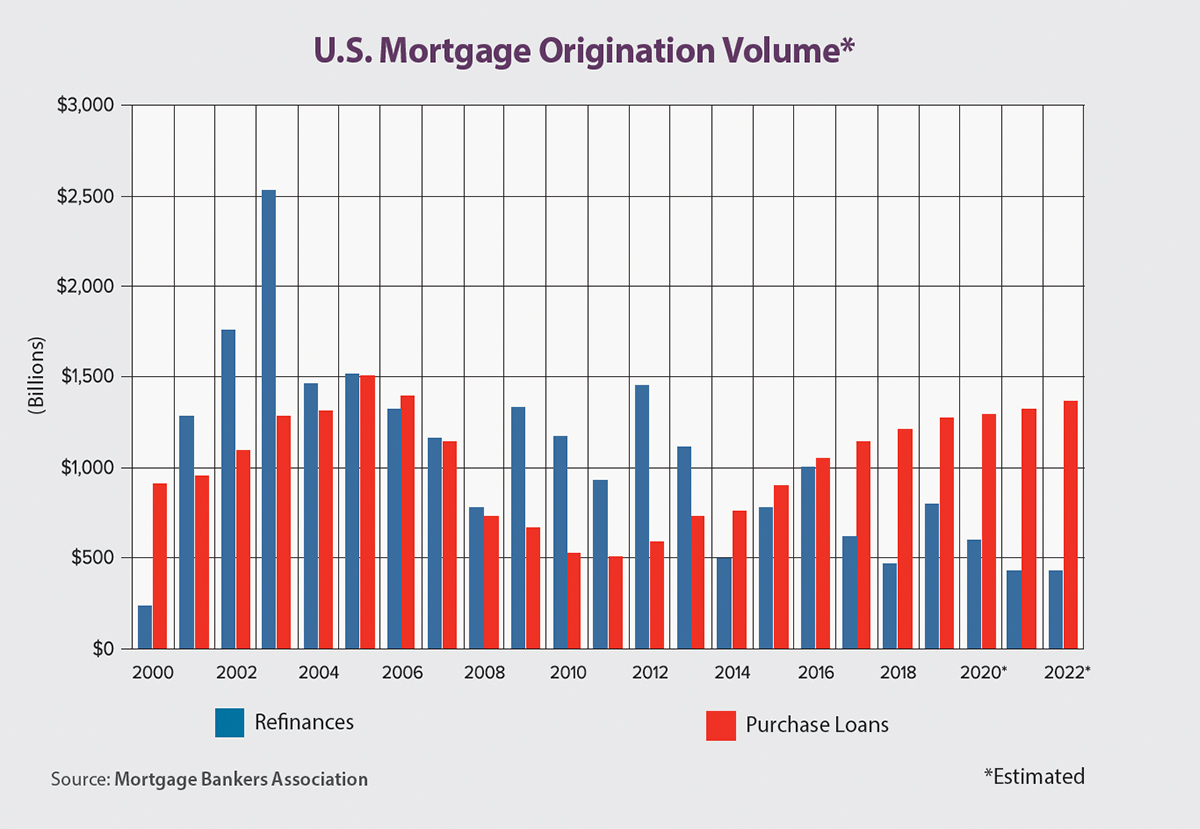What a difference a year can make. When economists and mortgage industry experts prepared their 2019 forecasts, the consensus was that mortgage rates would hover around 5%, refinance activity would continue to decrease and mortgage lenders’ business would primarily consist of home-purchase loans.
Fast forward to today and the landscape is quite different. Mortgage rates dropped during summer 2019 and remained below 4% for much of the second half of last year. As a result, lenders have had reason to celebrate as refinance originations in 2019 are now expected to close the year at $793 billion — the highest level since 2016.
Meanwhile, although purchase activity continues to trend higher than a year ago, low supply and affordability challenges continue to hinder some prospective homebuyers. The purchase market is strong but it could be performing much better, given the low rate environment and healthy U.S. labor market. As 2019 drifts into the rearview mirror, the Mortgage Bankers Association (MBA) estimates that overall mortgage origination volume will end the year at about $2.06 trillion — the best performance since 2007 ($2.31 trillion).
The good news for mortgage lenders, originators and borrowers is that “lower for longer” is the motto for our 2020 mortgage rate forecast. Slower economic growth will likely cause the 10-year Treasury rate to increase gradually to about 1.9% this year. Mortgage rates will follow, although not step for step, and are predicted to slowly rise to about 4%.
The U.S. economy continues to expand — as of this past October, it had experienced uninterrupted growth on a monthly basis for more than a decade. So, why have rates been so low recently? Blame geopolitical uncertainty and a slowdown in the global economy, as well as the long-lasting trade war between the U.S. and China, for dialing up investor unease and causing bouts of financial-market volatility. The U.S. remains the brightest star in the global economy, but these headwinds show little signs of dissipating.
After decent economic growth of about 2% in the latter part of 2019, our expectation is for gross domestic product to downshift to about 0.9% expansion in 2020. Growth in the first half of this year is expected to be particularly slow. The continued negative effects from the ongoing trade war and global uncertainty pose threats that could lead to even slower economic growth while keeping the Federal Reserve from considering any moves to raise short-term rates in 2020.
Although rates will remain low, the expectation of even a slight increase means that refinance originations also are likely to slow this year, falling by 24.5% year over year to $599 billion. Fewer refinances is why MBA expects a roughly 8.3% pullback in total originations to $1.89 trillion in 2020.
The purchase-loan market, however, should remain relatively strong. One promising development witnessed last year was the rise of new and existing housing supply in many markets, which led to slower home-price growth. After several years of price appreciation that greatly exceeded income growth, this year’s moderating home prices should be considered a good sign as they allow household incomes to catch up with home values.
This year’s housing market also will continue to be supported by favorable demographic trends. Millennials are continuing to enter their prime homebuying years and more of them are reaching major life milestones — such as getting married and having children — that make homeownership a more appealing option. Favorable demographic and improving affordability trends amidst rising housing supply are the main reasons why we are forecasting purchase-mortgage originations to increase by 1.6% to $1.29 trillion in 2020.
Against the backdrop of the global turmoil of last year, consumer spending and sentiment remain relatively strong because of the underlying strength of the job market, but we do expect slower job growth next year. This could lead to more cautious spending from some consumers. The U.S. economy will have to navigate some obstacles in 2020 but, overall, mortgage lenders and originators should expect their phone lines — and, increasingly, their online platforms and mobile apps — to remain busy.
Author
-

Mike Fratantoni is chief economist and senior vice president of research and industry technology at the Mortgage Bankers Association (MBA). He is responsible for overseeing MBA’s industry surveys, benchmarking studies, economic and mortgage origination forecasts, industry-technology efforts, and policy-development research for the single-family and commercial/multifamily markets. Prior to joining MBA, Fratantoni worked in risk management and senior economist roles at Washington Mutual and Fannie Mae.
View all posts







